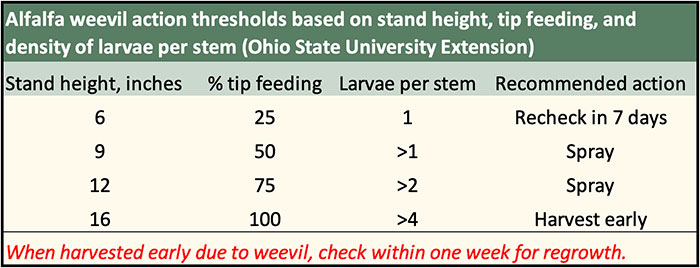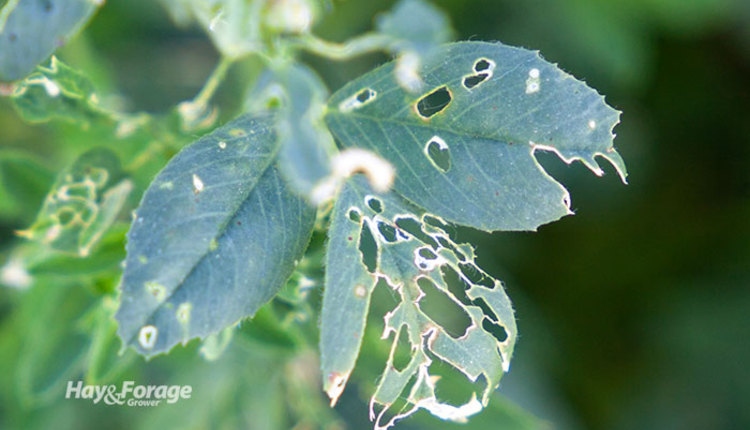The evil of alfalfa weevil |
| By Amber Friedrichsen, Associate Editor |
|
|
|
Warmer weather is drawing insects that overwinter out of dormancy, and alfalfa weevils are no exception. Start scouting these insects now to limit the damage they can do to plant leaves before first cutting. In a recent article in the C.O.R.N. Newsletter from Ohio State University Extension, a team of researchers and field specialists explain that alfalfa weevil adults start to lay eggs when temperatures exceed 48°F. Then the most plant injury occurs between 325 and 575 heat units when larval activity is at its peak. Warm temperatures early in the spring can push larvae development ahead of schedule, and fields with a south-facing slope may experience greater pest pressure as well. That said, a late-season cold snap can exacerbate issues with alfalfa weevils even more. The authors say this pattern results in an abundance of larvae that are old enough to feed on alfalfa even though plant growth has slowed. Scouting methods Scout forage stands for alfalfa weevils weekly. Look for holes in leaf tips and collect plant samples to quantify pests. Take 10 plant stems from random locations in a field and put them in a bucket with stem tips facing down. Vigorously shake the stems inside the bucket and count the larvae that are dislodged. Divide the total number of larvae by 10 to find the average number of insects per stem. Repeat this process at least three times. The authors note alfalfa weevils have four life stages, which are called instars. Shaking stems dislodges third- and fourth-instar larvae from plants, and weevils do the most feeding damage during these stages. First- and second-instar larvae typically cause less damage, but their presence may indicate future pest problems. Treatment thresholds In addition to larvae per plant stem and insect life stage, treatment thresholds also account for plant height. The following table provides recommended actions to take depending on these three factors.  The authors emphasize early harvest is almost always advised when alfalfa is more than 16 inches tall and weevil larvae are causing significant damage. Farmers can also cut alfalfa when plants are between 12 and 16 inches instead of spraying herbicide if weevils are wreaking havoc on their crop and doing so justifies harvest costs. Inspect forage after early harvests to ensure larvae do not prevent regrowth. Continue scouting stands once a week to determine if and when it is necessary to take subsequent action against alfalfa weevil in the new regrowth.  Amber Friedrichsen Amber Friedrichsen served as the 2021 and 2022 Hay & Forage Grower summer editorial intern. She currently attends Iowa State University where she is majoring in agricultural communications and agronomy. |

